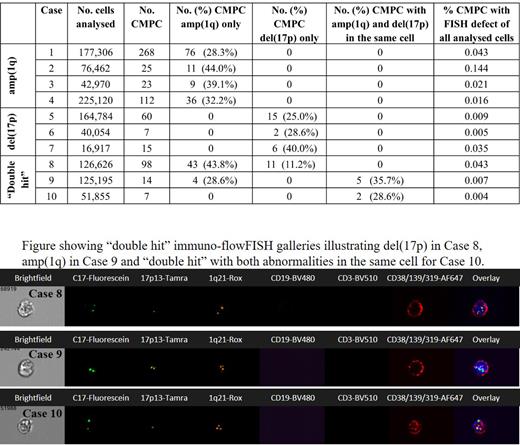“Double hit” myeloma is defined as the presence of 2 of the known high-risk genetic abnormalities in myeloma. This includes amp(1q), del(17p) and IGH translocations involving chromosomes 4, 16 and 20. Given the prognostic significance of these abnormalities, with poor overall survival, identification is crucial. Testing is traditionally by fluorescence in situ hybridization (FISH) on a single-site bone marrow sample at baseline or at specific disease timepoints. We explored whether amp(1q) and del(17p) “double hit” abnormalities could be detected in circulating myeloma plasma cells (CMPC).
Aims: We assessed our novel imaging flow cytometry method that simultaneously integrates immunophenotyping and FISH. Called “immuno-flowFISH” this single cell method combines antigenic detection of neoplastic plasma cells, FISH for DNA loci of interest and imaging flow cytometry for automated assessment.
Methods: Blood from 16 myeloma patients, at diagnosis or on therapy was studied. Following density gradient centrifugation, cells were incubated with CD38/CD138/CD319-AF647-conjugated antibodies to identify plasma cells, CD19-BV480 (to differentiate normal from neoplastic plasma cells) and CD3-BV510 (T-lymphocyte control). After fixation and cell membrane permeabilization, DNA was denatured (78 oC for 5 minutes). The cells were then incubated with FISH probes to 1q21 ( CKS1B) and 17p13 loci, and to the centromere of chromosome 17 (C17), and hybridized (24 hours for 37 oC). The nuclei were stained with SYTOX AADvanced and 50,000 to 500,000 cells acquired on the Amnis ® ImageStream ®X Mk II imaging flow cytometer (Cytek Biosciences). Digital images and quantitative data derived from computational algorithms (IDEAS software) were used to assess FISH signals overlying the counterstained nuclei.
Results: A mean of 264,937 cells were acquired and 110,696 analysed. Cells with a neoplastic plasma cell phenotype (CD38/CD138/CD319-positive, CD19-negative) were present in all samples. The number of these CMPC ranged from 7 to 797, amounting to 0.011- 0.546% of all cells. FISH abnormalities were present in CMPC of 10 of the 16 cases (see Table). Isolated amp(1q) (three CKS1B FISH signals) was present in 4 cases, and isolated del(17p), (one 17p13 and two C17 FISH spots) in CMPC in 3 cases. “Double hit” abnormalities, with both amp(1q) and del(17p), were present in another 3 cases, with the following cytogenetic patterns (illustrated in the Figure):
1. amp(1q) and del(17p) in different cells (Case 8);
2. amp(1q) and del(17p) in the same cell (35.7% of CMPC), in addition to isolated amp(1q) (28.6% of CMPC) (Case 9);
3. amp(1q) and del(17p) in the same cells only (Case 10).
All circulating myeloma plasma cells had diploid signals for the chromosome C17 centromeric probe and the CD3-positive T-cells diploid signals for all probes.
Conclusion: Incorporating antigenic identification and FISH, with imaging flow cytometric analysis, can detect “double hit” amp(1q) and del(17p) in circulating myeloma plasma cells at high sensitivity (10 -5). This novel approach allowed sub-clonal interrogation, with amp(1q) and del(17p) “double hits” detected in the same (Cases 9, 10) and separate CMPC (Case 8). It could also identify sub-clonal acquisition of secondary del(17p) (Case 9), which may be a consequence of disease evolution or intra-tumoral clonal heterogeneity. FISH analysis of circulating plasma cells using a flow cytometric platform is achievable to low levels of disease through assessment of thousands of cells. It holds significant promise for sensitive holistic real-time blood surveillance to detect high-risk and sub-clonal “double hit” alterations at the single cell level. Blood monitoring for these genetic aberrations overcomes the limitations of single site marrow analysis and may provide insights into the disease trajectory, clonal evolution and prognosis.
Disclosures
Erber:Patent: Patents & Royalties: Erber, Fuller, Hui. Improvements in or relating to cell analysis. AU2018051148 (Australia, 2018); US20200232019 (USA, 2020); CN111448324 (China, 2020); EP2018870567 (Europe, 2020); Luminex Corporation: Research Funding; AbbVie: Research Funding; Imago Biosciences: Research Funding; ThermoFisher Scientific: Research Funding; Cytek Biosciences: Research Funding; Scopio Labs: Other: Advisor; Sysmex Corporation: Honoraria. Hui:Patent: Patents & Royalties: Erber, Fuller, Hui. Improvements in or relating to cell analysis. AU2018051148 (Australia, 2018); US20200232019 (USA, 2020); CN111448324 (China, 2020); EP2018870567 (Europe, 2020). Chuah:Thermo Fisher Scientific: Research Funding; AbbVie: Honoraria. Sidiqi:Pfizer: Membership on an entity's Board of Directors or advisory committees; Janssen: Membership on an entity's Board of Directors or advisory committees, Speakers Bureau; Antengene: Speakers Bureau; Gilead: Speakers Bureau; BMS: Speakers Bureau. Fuller:Cytek Biosciences: Research Funding; AbbVie: Research Funding; Millennium Science Pty Ltd: Honoraria; Patent: Patents & Royalties: Erber, Fuller, Hui. Improvements in or relating to cell analysis. AU2018051148 (Australia, 2018); US20200232019 (USA, 2020); CN111448324 (China, 2020); EP2018870567 (Europe, 2020); Imago/Merck: Research Funding.


This feature is available to Subscribers Only
Sign In or Create an Account Close Modal